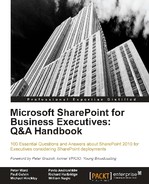Chapter 1, Defining a SharePoint IT Strategy, outlines the first broad process of solving business problems with the SharePoint technology and to fully understand the magnitude of the business issues.
Chapter 2, Just Enough Governance, bridges the gap between the uncontrolled environment so often seen with a SharePoint environment, and the approval and documentation-heavy processes you see in other business areas. It introduces the topic of governance in such a way that most business executives and IT leadership understand inform the readers that SharePoint can be governed just like every other platform.
Chapter 3, Deployment Roadmap, gives readers the appropriate introductory knowledge to aid them in deciding how to go about installing or upgrading SharePoint within their organizations. With a myriad of available versions and deployment options including on-premise, hosted, and cloud-based, business executives need to know what their options are, what their concerns should be, and what criteria to use to best choose the optimal venue for their SharePoint deployment.
Chapter 4, SharePoint in the Clouds, addresses important considerations for cloud-based SharePoint deployments, with a focus on Office 365 (Microsoft's premier offering) and Amazon EC2, the largest available public/private cloud. As cloud technologies mature, they are becoming more attractive to organizations for production use, and IT management needs to know the benefits and pitfalls of what the cloud can do for SharePoint.
Chapter 5, SharePoint and Important Trends, outlines IT trends that affect a SharePoint deployment in your company and educates the reader that SharePoint is not a simple application. It's an enterprise platform that is used in many different disciplines, industries, and corporate cultures. In this chapter, we explore how SharePoint is being used and leveraged within vertical markets and horizontal markets. In order to effectively determine how to invest in your SharePoint implementation, it's important to understand Microsoft's positioning, the vendor marketplace, SharePoint's competitors, and industry trends that will impact your SharePoint investments.
Chapter 6, How to get the .NET Developers on Board Quickly?, provides an approach to bring .NET developers up to speed quickly and avoid the pitfalls many other organizations have inadvertently stumbled over in the last few years. Microsoft will be the first to tell you that SharePoint is itself a .NET platform. It follows that since .NET is a mature and widely adopted technology, you'll have a rich and deep market of resources from which you can draw highly skilled SharePoint developers with minimum effort. Similarly, you may reasonably believe the same of your existing, .NET-skilled IT staff. However, you'll also quickly find that SharePoint requires your development team to acquire a fair amount of specialized knowledge.
Chapter 7, Growing SharePoint Capacity and Meeting Staffing Resource Needs, delves into what skill sets are required for SharePoint implementations, how to evaluate what your real staffing needs are, how to leverage existing resources more effectively within the organization, and how to evaluate external experts/consultants to augment your organization's capabilities. As SharePoint implementations grow and become more successful within your organization, how do you handle managing, evaluating, and acquiring the necessary talent to keep it going?
Chapter 8, Managing your First SharePoint Project, discusses criteria for selecting that "first" project, pitfalls to avoid, and best practices to follow to ensure that it's both a successful project and a template and shining example that will help your organization move forward with confidence and success with SharePoint. Many companies' first SharePoint projects fail to meet the business requirements that justified their investment in the first place, let alone provide lasting value down the road. That's a shame because it does not need to, and should not, turn out that way.
Chapter 9, Now What?, wraps up the book's objective to give the reader the ability to make positive and permanent shifts in their decision-making ability regarding SharePoint's impact and their business needs. These shifts are the direct cause for a new and unique kind of IT management perspective where the reader has the ability to further become both a SharePoint influencer and decision maker in areas that are important to them and the business.
For this book to be of value, you will need an open mind to absorb and interpret the advice and experiences of the authors on the SharePoint topics that each chapter addresses. This is key, because the book's emphasis is on planning, managing, and supporting SharePoint deployments, rather than a survival step-by-step guide to a technical task.
You will also need the ability to reapply information stated in the chapter topics to SharePoint projects that you are working on or are about to be working on. This information is not always going to be 100 percent relevant to how your organization works with the SharePoint technology, so not everything should be taken literary. The authors view this information as pointers to the truth, not as the truth itself. To become an experienced manager of SharePoint deployments you must experience the truth, and not always believe it.
